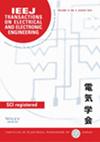下载PDF
{"title":"基于细胞的晶体管检测细胞膜蛋白用于液体活检","authors":"Miyuki Tabata, Yuji Miyahara","doi":"10.1002/tee.70124","DOIUrl":null,"url":null,"abstract":"<p>Liquid biopsy has caught the attention of medical doctors for diagnosing or managing diseases through less invasive testing of body fluids. In liquid biopsy, there are various markers used to detect cancer, such as small nucleic acids and circulating tumor cells (CTCs), along with extracellular vesicles (EVs). Detecting CTCs in patients' blood is crucial, as it provides important information about proteins and sugar chains on their membranes and the nucleic acids inside. However, detecting CTCs is difficult because they are rare compared to the millions of blood cells present. To address this challenge, we propose a new method using ion-sensitive field-effect transistors (ISFETs) combined with chemical signal amplification through enzyme reactions to detect cell membrane proteins. We tested this method using breast cancer cell lines as models for CTCs and successfully detected human epidermal growth factor receptors (HER2 and EGFR) on their membranes using cell-based transistors. Initially, we demonstrated the detection of HER2 through an enzyme reaction using the BT474 breast cancer cell line. Then, we compared EGFR expression among four types of breast cancer cell lines using the cell-based transistors, and the results were consistent with fluorescence detection using fluorescence-activated cell sorting (FACS). These cell-based transistors offer advantages in terms of miniaturization and analyzing target molecules on cell and EV membranes in parallel. Their small size and cost-effectiveness for cancer testing could make them a reality in future liquid biopsy methods. In this review, we present our recent advancements in cell-based transistors. We will then explore the future prospects of cell-based transistors in liquid biopsy. © 2025 Institute of Electrical Engineers of Japan and Wiley Periodicals LLC.</p>","PeriodicalId":13435,"journal":{"name":"IEEJ Transactions on Electrical and Electronic Engineering","volume":"20 10","pages":"1526-1533"},"PeriodicalIF":1.1000,"publicationDate":"2025-08-17","publicationTypes":"Journal Article","fieldsOfStudy":null,"isOpenAccess":false,"openAccessPdf":"https://onlinelibrary.wiley.com/doi/epdf/10.1002/tee.70124","citationCount":"0","resultStr":"{\"title\":\"Cell-Based Transistors Detecting Cell Membrane Proteins for Liquid Biopsy\",\"authors\":\"Miyuki Tabata, Yuji Miyahara\",\"doi\":\"10.1002/tee.70124\",\"DOIUrl\":null,\"url\":null,\"abstract\":\"<p>Liquid biopsy has caught the attention of medical doctors for diagnosing or managing diseases through less invasive testing of body fluids. In liquid biopsy, there are various markers used to detect cancer, such as small nucleic acids and circulating tumor cells (CTCs), along with extracellular vesicles (EVs). Detecting CTCs in patients' blood is crucial, as it provides important information about proteins and sugar chains on their membranes and the nucleic acids inside. However, detecting CTCs is difficult because they are rare compared to the millions of blood cells present. To address this challenge, we propose a new method using ion-sensitive field-effect transistors (ISFETs) combined with chemical signal amplification through enzyme reactions to detect cell membrane proteins. We tested this method using breast cancer cell lines as models for CTCs and successfully detected human epidermal growth factor receptors (HER2 and EGFR) on their membranes using cell-based transistors. Initially, we demonstrated the detection of HER2 through an enzyme reaction using the BT474 breast cancer cell line. Then, we compared EGFR expression among four types of breast cancer cell lines using the cell-based transistors, and the results were consistent with fluorescence detection using fluorescence-activated cell sorting (FACS). These cell-based transistors offer advantages in terms of miniaturization and analyzing target molecules on cell and EV membranes in parallel. Their small size and cost-effectiveness for cancer testing could make them a reality in future liquid biopsy methods. In this review, we present our recent advancements in cell-based transistors. We will then explore the future prospects of cell-based transistors in liquid biopsy. © 2025 Institute of Electrical Engineers of Japan and Wiley Periodicals LLC.</p>\",\"PeriodicalId\":13435,\"journal\":{\"name\":\"IEEJ Transactions on Electrical and Electronic Engineering\",\"volume\":\"20 10\",\"pages\":\"1526-1533\"},\"PeriodicalIF\":1.1000,\"publicationDate\":\"2025-08-17\",\"publicationTypes\":\"Journal Article\",\"fieldsOfStudy\":null,\"isOpenAccess\":false,\"openAccessPdf\":\"https://onlinelibrary.wiley.com/doi/epdf/10.1002/tee.70124\",\"citationCount\":\"0\",\"resultStr\":null,\"platform\":\"Semanticscholar\",\"paperid\":null,\"PeriodicalName\":\"IEEJ Transactions on Electrical and Electronic Engineering\",\"FirstCategoryId\":\"5\",\"ListUrlMain\":\"https://onlinelibrary.wiley.com/doi/10.1002/tee.70124\",\"RegionNum\":4,\"RegionCategory\":\"工程技术\",\"ArticlePicture\":[],\"TitleCN\":null,\"AbstractTextCN\":null,\"PMCID\":null,\"EPubDate\":\"\",\"PubModel\":\"\",\"JCR\":\"Q4\",\"JCRName\":\"ENGINEERING, ELECTRICAL & ELECTRONIC\",\"Score\":null,\"Total\":0}","platform":"Semanticscholar","paperid":null,"PeriodicalName":"IEEJ Transactions on Electrical and Electronic Engineering","FirstCategoryId":"5","ListUrlMain":"https://onlinelibrary.wiley.com/doi/10.1002/tee.70124","RegionNum":4,"RegionCategory":"工程技术","ArticlePicture":[],"TitleCN":null,"AbstractTextCN":null,"PMCID":null,"EPubDate":"","PubModel":"","JCR":"Q4","JCRName":"ENGINEERING, ELECTRICAL & ELECTRONIC","Score":null,"Total":0}
引用次数: 0
引用
批量引用


 求助内容:
求助内容: 应助结果提醒方式:
应助结果提醒方式:


